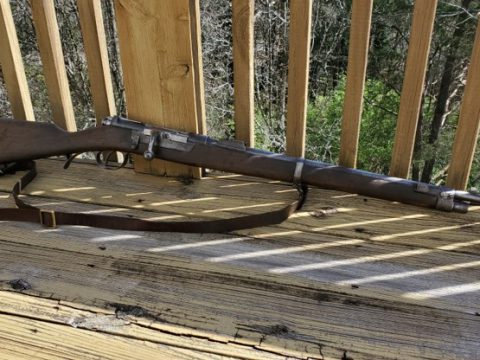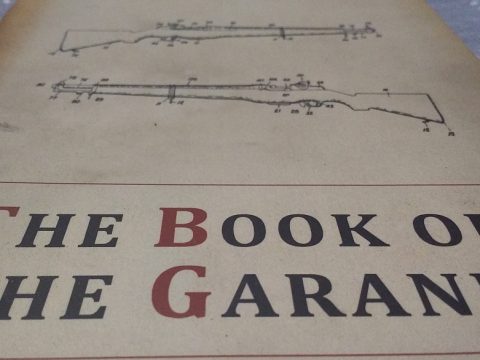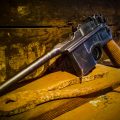East India Avenue lay just off Leadenhall Street in the heart of the City of London. The area was a maze of passageways, wine vaults, warehouses and cramped offices where opportunities could be found and money could be made. Number 3 East India Avenue was home to a company called Schwarte and Hammer. The “Post Office London Directory” for 1891 lists them as “Metal Merchants” but that bland term covered a diverse range of interests. They dealt in all sorts of commodities, wire and nails, nuts and bolts, metals including copper, iron and lead, chemicals like sulphur and stearine, cement and window glass for the building trade and, along with everything else, firearms.
Guns might have been just a part of their business, but they were active and enthusiastic arms dealers who were happy to sell rifles to anyone, even potential enemies of the Queen, and they were willing to stretch the law to breaking point by colluding with their clients in arms smuggling.
We know what they sold because they placed an advertisement in the December 1892 issue of “Arms and Explosives” magazine which proudly proclaimed that they were merchants in “New and Second-Hand Arms and Ammunition”, selling new Mannlicher, Mauser, Martini-Henry rifles, second hand breech loaders -particularly those made by Peabody, Remington, Werndl, Chassepot, Snyder (sic) as well as old Enfield and Springfield muzzle loaders and “Tower muskets”. From top of the range to functional but antique, they offered a firearm for every budget, no matter how modest. Surrounded as they were by ship owners, insurers, and merchants of all kinds in the centre of world commerce they were perfectly placed to sell weapons around the world.
They weren’t a big or famous name in the firearms trade and it’s only because they were unwise enough to write down some of their smuggling tips that they remain known to history at all.
There were many more metal merchants just like them all over Europe, because this was a time of plenty for the small arms dealer. Technological change, particularly the French development of smokeless powder that rendered a whole generation of military rifles obsolete almost overnight had provided them with ready supplies of cheap stock. There was world wide demand too, especially in the middle east, and it’s that trade that I’m going to focus on.
In early 1898, the SS “Baluchistan” was nearing the end of a six week journey from London during which she had passed through the Suez canal, the Arabian sea and into the Gulf. She was heading for the port of Muscat. In her hold were eight thousand rifles and seven hundred thousand cartridges. Some of these rifles had been bought by an Indian merchant, Ratansi Purshottam, from suppliers in Britain. They were not ordered for a single specific customer. Ratansi know he would be able to sell these rifles on after they arrived in Muscat, and he expected to make a profit.
On January 24th the British man of war, HMS Lapwing, boarded the ship in the seas off Muscat and seized the cargo. The result was a bewildering series of court cases, claim and counter claim, questions in the house and a deputation to the foreign office and that “most superior person” – George Nathaniel Curzon.
The British governments public rationale for this action was a convoluted one that was challenged at the time, based as it was on a number of facts but also more dubious claims.
The trade in arms from Britain to the Gulf was an increasingly lucrative one in the 1890s, especially for the Birmingham arms trade.
Ironically, one reason for this was a treaty – the “General Act of Brussels” of 1890, in which seventeen nations, including Britain and France, prohibited “the importation of firearms, and especially of rifles and improved weapons, as well as of powder, ball and cartridges” in the vast swath of Africa between the “20th parallel of North latitude and the 22d parallel of South latitude”. The treaty was very specific in that it was only modern firearms designed for “accurate firing” that were banned – those that were magazine fed, breech loading or rifled. It was still possible to sell smooth-bored flintlock weapons, as long as these were delivered only to properly regulated warehouses that would sell them only to those who had appropriate permits to own them.
This treaty might have appeared to be a noble attempt to stop slavery and violence and for the “preservation of the African population” but it was as much as anything a “gentlemen’s agreement” between Imperialist states that meant the process of colonisation could continue in an orderly fashion and without the inconveniences that could arise from having to encounter intractable “natives” armed with modern firearms. (1)
One unintended (by the British at least) consequence of this treaty was that the arms trade shifted northwards, towards the ports of the Gulf and Arabia
Guns normally arrived in the port of Bushire, which was part of the Persian empire, or the port of Muscat which was an independent Sultanate.
The growth of the trade was summarised in 1897 by the Consul-General at Bushire who reported that in the 1895 the arms trade across the whole “Persian Gulf” was worth £68,152, which grew to £140,443 in 1896 and £181,977 in 1897.
In Birmingham alone, at least thirteen gun and ammunition makers were regularly engaged in the trade by 1897, including famous names such as Kynoch and Eley Brothers. (2)
What complicated the matter was that the whole trade could be interpreted as not only being unlawful but potentially against British interests.
In 1881 a previous Shah of Persia had issued a proclamation that the traffic of arms into Persia was prohibited – although the text of this was rather unclear and could have been interpreted to mean “Unless the appropriate customs duties are paid”.
In any event, as long as the right people were paid the right amount the trade continued openly and was a real success for the Birmingham gun makers.
However, it seems clear that there was an increasing nervousness about this trade amongst British government officials in both the Gulf region and in India and Afghanistan throughout the 1880s and 1890s. There was a particular concern that high quality military weapons, especially Martini-Henry rifles, might end up in the hands of troublesome tribesmen on the fringes of British India. The nervousness is understandable – given the wider context of the “Great Game” – Russian attempts to expand into Afghanistan and possibly even India.
The frontier was dangerous place and throughout the 1890s it became clear that it was becoming more dangerous than ever because modern weapons were turning up in the hands of the local population in increasing numbers.
The expedition to relieve the besieged fort at Chitral in 1895 provided a horrible shock. Empire troops were faced by an enemy who had modern weapons and considerably more ammunition than they did. After the campaign was over analysis of captured weapons showed that most of them were indeed British made Snider and Martini-Henry rifles, but they had not entered the area through some nefarious route – the government had given them to a local warlord as gifts and he had subsequently sold them on or given them away as well. The British had brought these rifles to the frontier and were paying the price for it.
However, there was a clear impetus for the British to look at all of the possible ways that modern rifles could reach the frontier so in January 1897 officials tried to analyse just where the rifles being imported from Britain into the Gulf actually ended up.
The result should have been encouraging: “It was estimated that of the Martini-Henry rifles, about 60 per cent, found their ultimate destination in Persian territory, 25 per cent, in Turkish territory, and the rest in Arabia…”
It was noted that there were apparently no means of checking or effectively preventing the arms and ammunition trade carried on in the Gulf ports. (3)
So the rifles were mostly staying in the Gulf region – they were not heading out to Afghanistan or the frontiers of India. Perhaps there was no need to worry after all.
However, the impression given by the documents is still one of officials having a queasy feeling that they couldn’t really be wholly certain that rifles supplied by British companies were not heading out of Muscat and Persian ports and being sent to some God-forsaken part of the Empire to shoot at some miserable British sentry.
In the Summer of 1897 the British suffered another shock with a series of revolts and uprisings amongst the tribes in the North-West frontier of India which started in the summer and saw a number of bloody encounters with a skilled enemy who now clearly possessed modern rifles, including the new Lee-Metford.
Later analysis of the rifles captured during these revolts showed that the majority were made up of parts of damaged or otherwise rejected rifles, or had been simply been stolen or captured from British troops, however the concerns that somehow someone outside the region was selling these rifles persisted.
Perhaps the government would not, or could not, admit to itself or the public that the main source of the rifles killing British soldiers was the government itself.
The uncertainty as to where the rifles were coming from is best summed up in a history of one of these violent episodes, the Tirah Expedition, written by an officer who served in it, originally published in the form of letters to the “Times”: “Some think they are imported from Birmingham or Belgium, and thence find their way via the Persian Gulf to the Indian frontier; some imagine that they are obtained from the Amir’s workshop in Cabul; and some believe they are stolen in India, and sold for fancy prices across the border. Probably from each of these sources the supply is maintained; but, whencesoever they get them, it is certain that the Afridis now possess Martinis in large numbers, and have besides an apparently unlimited stocks of ammunition.” (4)
The uncertainty is palpable in a diplomatic telegram sent on the 22nd October 1897 by Lieutenant-Colonel Meade (Gulf Resident 1897–1900) who said: “It did not appear that arms were taken via Bushire to Afghanistan, but it was known that large quantities constantly consigned to Maskat were carried by native boats to Bunder Abbas, whence their ultimate destination was unknown, but that the British Agent at Lingah would enquire secretly and report.”
The same telegraph contains the information that Meade recommended that the Resident at Aden should be advised to: “watch cargoes of arms transhipped for the Persian Gulf, and to send particulars by telegraph, it was further suggested that the Persian Government should be urged strictly to enforce the existing orders against the importation of arms into Persia, on the ground that danger would follow to trade and internal tranquillity if it were not checked.” (5)
It’s this recommendation that seems to have led to the seizure of the SS Baluchistan and to the fury of the Birmingham gun trade.
Throughout the summer of 1898 the argument was played out in the pages of the trade magazine “Arms and Explosives”, which devoted many pages to an excoriating demolition of the governments case and the frustration of the gun makers
When the Birmingham Gun Trade Annual meeting was held in 1898 the magazine summarised the anger of the attendees as follows:
Everyone knew that the prohibition of the trade was “nominal”, after all it had been carried on for eighteen years.
There was no evidence for these rifles being used against British troops in India or Afghanistan, indeed the government had “not the shadow of an excuse for any such assumption”
The suppression “seriously injured an important branch of the Gun Trade”
Because this was a de facto lawful trade the seizure was “arbitrary and without justification”.
If British dealers didn’t sell these rifles someone else would – “This was a trade in which they encountered very serious opposition…”
What the gunmakers wanted was the return of the seized goods and a meeting with the Prime Minister, Lord Salisbury, to “put the matter clearly and effectively before the Premier. (Applause).” (6)
What they got was rather less satisfactory. On June the ninth 1898, a deputation from the Birmingham gunmakers association met with the Under Secretary to the Viceroyalty of India, Lord Curzon, at the Foreign office and put their case to him in great detail, however, “To their great surprise, they received no kind of satisfaction”.
Curzon restated the governments case – that the trade was illegal, threw in some comments about the murder of a British subject, an increase in Gulf piracy and again claimed that the Persian government had initiated the seizure anyway and that was that.
The members were furious at this patrician fobbing off of mere tradesmen. An editorial in Arms and Explosives said that the Foreign Office had…”in the person of it’s logic-chopping Under Secretary, made a very poor show up to the present.” (7)
Curzon’s arguments appear to be based on a memorandum written on June the third by Sir William Leigh-Warner of the India office. This contains some interesting details about the dubious practices of the importers, in that destination ports were changed in some cases in apparent attempt to hide final destinations. The memo also addresses the core accusation, that British gunmakers were selling to the enemies of the Queen Empress, in a rather more circumstantial manner, claiming that “Afghan Emissaries” were awaiting the arrival of the Baluchistan, and the fact that none of the weapons surrendered by the frontier tribes “corresponded to the arms known to have been sent to Maskat” was irrelevant because it was claimed that the tribesmen were fooling the government by only giving up “worthless, stolen, or specially made up” arms. No mention was made of the weapons supplied by the government as gifts to tribal leaders.
In its conclusion the memo made a clear statement of policy – this trade was “inimical to British interests” (8)
There may have been elements of truth in the Governments evidence but there is a definite feeling that the their arguments were arrived at “after the fact” as an explanation for a fait accompli – and that seems to have been the feeling of the gunmakers as well.
The argument grumbled on for several years, with claim and counter claim by the gunmakers and the government, court cases for breach of contract making rulings that supported the gunmakers claims and union representatives complaining that their members were suffering as a result of the closure of the trade.
In 1899 the Prime Minister refused to comment on the matter further and the same year saw a “curious” court case where a judge and jury found the seizure of the weapons on the “Baluchistan” to be arbitrary and unlawful under English law. However, after hearing advice from counsel and “without further assistance from the jury” the Judge contradicted his earlier judgement and found the seizures to be lawful under Muscat law and that they should therefore stand. This judgement was itself set aside at appeal in 1900 and damages awarded to the exporters. The exporters were not satisfied and by 1901 Lieutenant-Colonel Meade was being personally sued by one of them.
“Arms and Explosives” wearily commented: “It is evidently not intended that the British public shall arrive at the true inwardness of the fire-arms seizure in the Persian Gulf”. (9)
In the end the ban remained in force and the Birmingham gunmakers were left feeling that the trade was paying for the governments panic and incompetence.
So what of Ratansi and his lost shipment of rifles?
It seems that the arms trade in the region was so profitable and widespread that it would take more than legal prohibition and the threat of the Royal Navy to stop it. The trade simply shifted location and methods until it eventually really did become the illicit trade that the British government had accused it of being.
One of Ratansi’s suppliers in England was the firm of Schwarte and Hammer, our original “Metal Merchants”. When it came to selling to Ratansi they were also quite happy to use loopholes in the rules limiting the firearms trade to the Gulf to make sure the rifles still got through. They may have followed the letter of the law, but certainly not its spirit.
For example, in 1906 news of an renewed attempt by the colonial powers to restrict the trade came to the traders of Muscat. Ratansi contacted Schwarte and Hammer and expressed his concerns that this could lead to a total ban on the trade into the port of Muscat. They wrote back urging him to remain calm – they would simply send numerous small shipments of rifles instead of a few large ones. Not only were they not obliged to even mention that a shipment contained rifles if it fell below a certain size or value, there was very little danger of overworked customs official catching so many small shipments. This appears to have been what they did, and the trade continued, underground and underhand, with merchants seemingly always one step ahead of officialdom.
It’s a perfect example of the nature of the arms trade of period. A myriad of small merchants with access to huge numbers of rifles, working in ways both open and clandestine to sell them to whoever wanted them. Attempts to stop or regulate the trade just made it more opaque and complicated to the point that officials simply could not understand how parts of the world were full of arms despite there being no “observable arms trade”. (10)
By the early years of the twentieth century the Gulf arms trade through Muscat was indeed fulfilling the fears of both the British government and the Birmingham gun makers. Not only was the trade clandestine, but weapons were certainly appearing in greater numbers than ever on the frontier and, worst of all, most of the weapons appeared to be being supplied by French traders. The question was why?
Small though individual traders might have been they existed in the wider context of great power politics.
One reason for the British desire to suppress the trade was to reduce dangers to the edges of her Empire in India and Afghanistan. The French were quite happy to support their Gulf arms traders, not only because some of them were wealthy and influential men but because they saw the trade in Muscat as a fair balance for British support of the arms trade in Morocco which led to an increase in the availability of arms in Algeria, another dangerous frontier of their own Empire. As such they supplied more and more of the rifles passing through Muscat, to the increasing frustration and irritation of the British and the increase of tension between the two nations.
What finally stopped the trade was a combination of pressures – on the international scale the Indian government made it clear that the flow of weapons had to be stopped, there was a desire from London to make a deal with the French that would alleviate a situation that threatened to break apart the relatively new alliance that seemed to offer the best hope of protection against German aggression, and on a local level the Sultan of Muscat, deeply in debt, was faced by increasingly angry and violent tribal violence. In 1911 Percy Cox explicitly threatened to withdraw British support for the Sultan if he didn’t break contacts with the arms dealers and set up a rigorously enforced bonded warehouse system that examined every shipment into the port of Muscat to find and seize illegally imported firearms.
Faced with this pressure, and with guarantees that both the French traders and he would be compensated for any losses the Sultan set up the warehouse in 1912. The result was the effective end of the clandestine trade through Muscat and a rebellion against the Sultan that was only suppressed by the intervention of British Indian regiments.
In the end, it all made no difference. The final irony of the whole situation is that the trade was stopped just before the start of a war that would see an even greater supply of modern rifles flood into the region. One study sums the situation up: “The spoils left by the Turkish and British armies, or given to the tribal allies of both, would soon dwarf the former private trade”. (11)
Schwarte and Hammer went out of business sometime after the First World War. Perhaps their name was just too Germanic to be tolerated in a nation reeling from appalling loss. Perhaps there was no point in trying to sell surplus rifles in a world already awash with them. East India Avenue has also gone. The whole block full of warehouses and dingy offices has disappeared beneath the huge gleaming footprint of the Lloyds Building. There’s no place for a small-time arms dealer in this part of the city anymore.
Acknowledgements:
I’m particularly indebted to Johan Mathews work on trafficking and free trade across the Arabian sea. His work forms the basis of much of this piece and it’s where I first heard of Schwarte and Hammer. Researching them led me to the treasure trove that is the trade journal “Arms and Explosives” and the complex and murky world of the arms dealers of this period of history.
Notes:
1 Slave trade and importation into Africa of firearms, ammunition, and spirituous liquors (general act of brussels) 1890 article ix available at https://www.loc.gov/law/help/us-treaties/bevans/m-ust000001-0134.pdf accessed 27/5/20
2 Arms and Explosives Volume VI number 74 pg 224, Arms and Explosives Volume VI number 71 pg 179.
3 “Persian Gulf gazetteer. Part 1. Historical and political materials. Précis on arms trade in the Persian Gulf.” [10r] (19/70), British Library: India Office Records and Private Papers, IOR/L/PS/20/C237, in Qatar Digital Library <https://www.qdl.qa/archive/81055/vdc_100023515244.0x000015> pg 7 (accessed 11 August 2019)
4 Col. Hutchinson H.D, “The Campaign in Tirah, 1897-1898”, (London, 1898), pp 224-5.
5 “Persian Gulf gazetteer” op cit pg 8
6 Arms and Explosives Volume VI number 69 pp 144-145.
7 Arms and Explosives Volume VI number 71 pg 169, 181
8 “Persian Gulf gazetteer” op cit pg 14
9 Arms and Explosives Volume VII number 82 pg 98.
10 Mathew, Johan “Margins of the Market: Trafficking and Capitalism Across the Arabian Sea” (University of California 2016) pg 93
11 Fiscus, James W., “Gun Running in Arabia: The Introduction of Modern Arms to the Peninsula, 1880-1914” (1987). Dissertations and Theses. Paper 1624.
https://pdxscholar.library.pdx.edu/open_access_etds/1624 Pg 103 (accessed 20 June 2020)
Interested in Military Rifles and the Arms Trade of the late Nineteenth Century. Loves the smell of archives in the morning.





